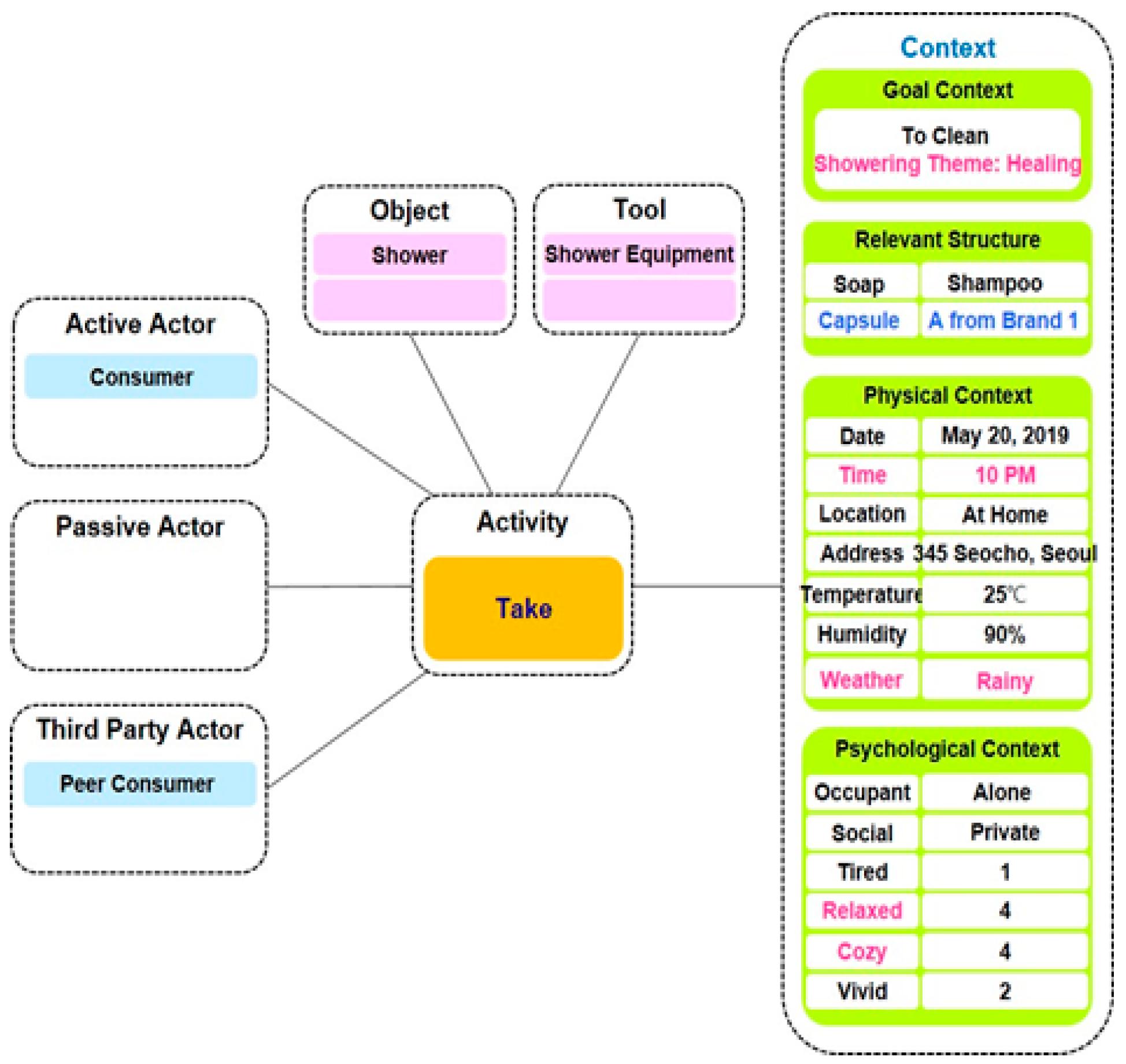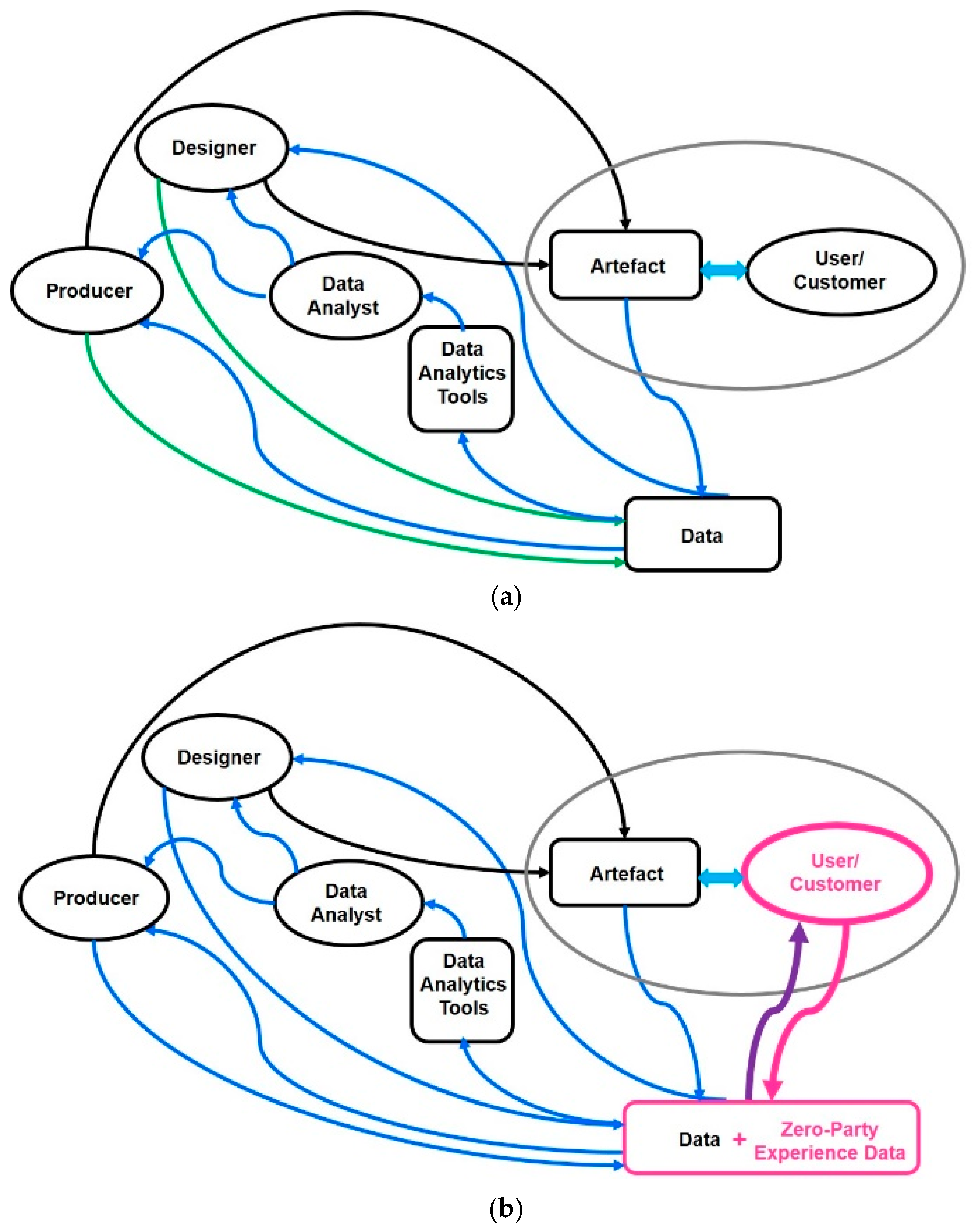Customer Experience Design for Smart Product-Service Systems Based on the Iterations of Experience–Evaluate–Engage Using Customer Experience Data
Abstract
1. Introduction
2. Methodology
3. Framework for Customer Experience Data
3.1. Context-Based Activity Modeling
3.2. Context-Specific Experience Sampling and Analysis
4. Experience Design Based on Customer Experience Data
4.1. Service Concepts for Experience–Evaluate–Engage
4.1.1. Real-Time Experience Evaluation Service Unit
4.1.2. Association of Experience Data and Context Data
4.1.3. Experience Data Provision Service Unit
4.1.4. Reflection and Engagement Service Unit
5. Demonstrative Cases
5.1. Case 1: Shower Equipment Smart PSS
5.2. Case 2: Smart Lighting Customization PSS
6. Discussions and Conclusions
Funding
Conflicts of Interest
References
- Goedkoop, M.J.; van Halen, C.J.G.; te Riele, H.R.M.; Rommens, P.J.M. Product Service Systems, Ecological and Economic Basics; The Dutch ministries of Environment (VROM) and Economic Affairs (EZ): Hague, The Netherlands, 1999. [Google Scholar]
- Tukker, A. Eight types of product–service system: Eight ways to sustainability? Experiences from SusProNet. Bus. Strat. Environ. 2004, 13, 246–260. [Google Scholar] [CrossRef]
- Tan, A.R.; McAloone, T.C. Characteristics of Strategies in Product/Service-System Development. In Proceedings of the 9th Inter-national Design Conference, Dubrovnik, Croatia, 15–18 May 2006; pp. 1435–1442. [Google Scholar]
- Tukker, A. Product services for a resource-efficient and circular economy—A review. J. Clean. Prod. 2015, 97, 76–91. [Google Scholar] [CrossRef]
- Kjaer, L.L.; Pigosso, D.C.; McAloone, T.C.; Birkved, M. Guidelines for evaluating the environmental performance of Product/Service-Systems through life cycle assessment. J. Clean. Prod. 2018, 190, 666–678. [Google Scholar] [CrossRef]
- Da Costa Fernandes, S.; Pigosso, D.C.; McAloone, T.C.; Rozenfeld, H. Towards product-service system oriented to circular economy: A systematic review of value proposition design approaches. J. Clean. Prod. 2020, 257, 120507. [Google Scholar] [CrossRef]
- Valencia, A.; Mugge, R.; Schoormans, J.P.L.; Schifferstein, H.N.J. The design of smart product-service systems (PSSs): An exploration of design characteristics. Int. J. Des. 2015, 9, 13–28. [Google Scholar]
- Costa, N.; Patricio, L.; Morelli, N.; Magee, C.L. Bringing Service Design to manufacturing companies: Integrating PSS and Service Design approaches. Des. Stud. 2018, 55, 112–145. [Google Scholar] [CrossRef]
- Dewit, I. Product-Service System Design, a Synthesis Approach; University of Antwerp: Antwerp, Belgium, 2019. [Google Scholar]
- Zine, P.U.; Kulkarni, M.S.; Chawla, R.; Ray, A.K. A Framework for Value Co-creation through Customization and Personalization in the Context of Machine Tool PSS. Procedia CIRP 2014, 16, 32–37. [Google Scholar] [CrossRef]
- Song, W.; Sakao, T. A customization-oriented framework for design of sustainable product/service system. J. Clean. Prod. 2017, 140, 1672–1685. [Google Scholar] [CrossRef]
- Kim, Y.S.; Hong, Y.K. A Systematic Method to Design Product-Service Systems Using Personalization Services based on Experience Evaluations. Int. J. Prod. Dev. 2019, 23, 353–385. [Google Scholar] [CrossRef]
- Ardolino, M.; Rapaccini, M.; Saccani, N.; Gaiardelli, P.; Crespi, G.; Ruggeri, C. The role of digital technologies for the service transformation of industrial companies. Int. J. Prod. Res. 2017, 56, 2116–2132. [Google Scholar] [CrossRef]
- Abramovici, M.; Göbel, J.C.; Neges, M. Smart engineering as enabler for the 4th industrial revolution. In Integrated Systems: Innovations and Applications; Fathi, M., Ed.; Springer: Berlin/Heidelberg, Germany, 2015; pp. 163–170. [Google Scholar]
- Chowdhury, S.; Haftor, D.; Pashkevich, N. Smart Product-Service Systems (Smart PSS) in Industrial Firms: A Literature Review. Procedia CIRP 2018, 73, 26–31. [Google Scholar] [CrossRef]
- Wang, Z.; Chen, C.-H.; Li, X.; Zheng, P.; Khoo, L.P. A context-aware concept evaluation approach based on user experiences for smart product-service systems design iteration. Adv. Eng. Inform. 2021, 50, 101394. [Google Scholar] [CrossRef]
- Cantamessa, M.; Montagna, F.; Altavilla, S.; Casagrande-Seretti, A. Data-driven design: The new challenges of digitalization on product design and development. Des. Sci. 2020, 6. [Google Scholar] [CrossRef]
- Liu, A.; Wang, Y.; Wang, X. Data-Driven Smart Product Service System. In Data-Driven Engineering Design; Springer: Cham, Switzerland, 2022. [Google Scholar] [CrossRef]
- Verhoef, P.C.; Broekhuizen, T.; Bart, Y.; Bhattacharya, A.; Dong, J.Q.; Fabian, N.; Haenlein, M. Digital transformation: A multidisciplinary reflection and research agenda. J. Bus. Res. 2019, 122, 889–901. [Google Scholar] [CrossRef]
- Schwab, K. The Fourth Industrial Revolution; World Economic Forum: Cologny, Switzerland, 2016. [Google Scholar]
- Verhoef, P.C.; Lemon, K.N.; Parasuraman, A.; Roggeveen, A.; Tsiros, M.; Schlesinger, L.A. Customer Experience Creation: Determinants, Dynamics and Management Strategies. J. Retail. 2009, 85, 31–41. [Google Scholar] [CrossRef]
- Zomerdijk, L.G.; Voss, C. Service Design for Experience-Centric Services. J. Serv. Res. 2009, 13, 67–82. [Google Scholar] [CrossRef]
- Lemon, K.N.; Verhoef, P.C. Understanding Customer Experience Throughout the Customer Journey. J. Mark. 2016, 80, 69–96. [Google Scholar] [CrossRef]
- McKim, R.H. Experiences in Visual Thinking; Wadsworth Publishing: Belmont, CA, USA, 1972. [Google Scholar]
- Kim, Y.S.; Park, J.A. Design Thinking in the Framework of Visual Thinking and Characterization of Service Design Ideation Methods Using Visual Reasoning Model. Des. J. 2021, 24, 931–953. [Google Scholar] [CrossRef]
- LOTAME. 1st Party Data, 2nd Party Data, 3rd Party Data: What Does It All Mean? 2019. Available online: https://www.lotame.com/1st-party-2nd-party-3rd-party-data-what-does-it-all-mean (accessed on 27 October 2021).
- Khatibloo, F.; Sridharan, S.; Stanhope, J.; Liu, S.; Joyce, R.; Turley, C. Consumer Data: Beyond First and Third Party. Decoding the Value of Four Consumer Data Types. 2017. Available online: https://www.forrester.com/report/Consumer-Data-Beyond-First-And-Third-Party/RES131910 (accessed on 20 May 2021).
- Forrester. Straight from the Source: Collecting Zero-Party Data from Customers. 2020. Available online: https://www.forrester.com/blogs/straight-from-the-source-collecting-zero-party-data-from-customers/ (accessed on 27 October 2021).
- Polonioli, A. Zero party data between hype and hope. Front. Big Data 2022, 5, 943372. [Google Scholar] [CrossRef]
- Kim, Y.S.; Lee, S.W. Service Design for Product-Service Systems using Context-Based Activity Modeling. In Proceedings of the International Association of Societies of Design Research (IASDR) Conference, Delft, The Netherlands, 31 October–4 November 2011. [Google Scholar]
- Kim, Y.S.; Jeong, J.; Hong, Y.; Hong, S. A Schema for Systematic Service Imagining: Context-Based Activity Modeling. Sustainability 2020, 12, 9558. [Google Scholar] [CrossRef]
- Kim, Y.S.; Hong, Y.K.; Kim, J.H.; Kim, Y.M. Context-Specific Experience Sampling for Experience Design Research. In Proceedings of the International Conference on Engineering Design (ICED11), Copenhagen, Denmark, 15–18 August 2011. [Google Scholar]
- Kim, Y.S.; Hong, Y.K. Real Time Experience Analyzing System and Method. U.S. Patent 10671645, 2 June 2020. [Google Scholar]
- Kim, Y.S.; Kim, J.H.; Hong, Y.K. Context-Specific Experience Sampling Method and System. U.S. Patent 11222348, 11 January 2022. [Google Scholar]
- Blessing, L.; Chakrabarti, A. DRM: A Design Research Methodology; Springer: Berlin/Heidelberg, Germany, 2009; pp. 13–42. [Google Scholar] [CrossRef]
- Bitner, M.J. Servicescapes: The Impact of Physical Surroundings on Customers and Employees. J. Mark. 1992, 56, 57–71. [Google Scholar] [CrossRef]
- Edvardsson, B.; Enquist, B.; Johnston, R. Cocreating Customer Value Through Hyperreality in the Prepurchase Service Experience. J. Serv. Res. 2005, 8, 149–161. [Google Scholar] [CrossRef]
- Kotler, P.; Armstrong, G. Principles of Marketing, 8th ed.; Upper Saddle River, N.J., Ed.; Prentice Hall International: London, UK, 1999. [Google Scholar]
- Klaus, P.; Maklan, S. Towards a Better Measure of Customer Experience. Int. J. Mark. Res. 2013, 55, 227–246. [Google Scholar] [CrossRef]
- Zarour, M.; Alharbi, M. User experience framework that combines aspects, dimensions, and measurement methods. Cogent Eng. 2017, 4, 1421006. [Google Scholar] [CrossRef]
- Csikszentmihalyi, M.; Larson, R.; Prescott, S. The ecology of adolescent activity and experience. J. Youth Adolesc. 1977, 6, 281–294. [Google Scholar] [CrossRef] [PubMed]
- Choi, Y.J.; Ahn, E.; Choe, Y.; Kim, Y.S. Smart Lighting Customization Service; Association of Human Subjective Experience Evaluation with Physical Context Information. In Asia—Design Engineering Workshop (A-DEWS); The Design Society: Osaka, Japan, 2016. [Google Scholar]
- Cho, C.K.; Kim, Y.S.; Lee, W.J. Economical, Ecological and Experience Values for Product-Service Systems. In Proceedings of the 7th Design & Emotion Conference, Chicago, IL, USA, 4–7 October 2010. [Google Scholar]
- Kim, Y.S. Digital Transformation Types for Product-Service Systems. In International Conference on Engineering Design (ICED21); The Design Society: Gothenburg, Sweden, 2021. [Google Scholar]
- Rodgers, C. Defining reflection: Another look at John Dewey and reflective thinking. Teach. Coll. Rec. 2002, 104, 842–866. [Google Scholar] [CrossRef]
- Kim, Y.S.; Kamal, R.; Nadeem, U.; Balakrishnan, R. Three Layers of Activities in Sustainable Experience Design Education: Gentle Introduction of Sustainability Issues for a Design Thinking Course. Sustainability 2022, 14, 6716. [Google Scholar]
- Kim, Y.S. A representation framework of product–service systems. Des. Sci. 2020, 6. [Google Scholar] [CrossRef]
- Kim, Y.S.; Lee, H. Process characteristics of Product-Service Systems development: Comparison of seven manufacturing company cases. J. Clean. Prod. 2020, 286, 124971. [Google Scholar] [CrossRef]
- Scollon, C.N.; Kim-Prieto, C.; Diener, E. Experience Sampling: Promises and Pitfalls, Strengths and Weaknesses. J. Happiness Stud. 2003, 4, 5–34. [Google Scholar] [CrossRef]
- Bolton, R.N.; Gustafsson, A.; McColl-Kennedy, J.; Sirianni, N.J.; Tse, D.K. Small details that make big differences. J. Serv. Manag. 2014, 25, 253–274. [Google Scholar] [CrossRef]
- Torres, E.N.; Lugosi, P.; Orlowski, M.; Ronzoni, G. Consumer-led experience customization: A socio-spatial approach. J. Serv. Manag. 2018, 29, 206–229. [Google Scholar] [CrossRef]
- Park, J.A.; Kim, Y.S. Visual Reasoning and Design Processes. In International Conference on Engineering Design (ICED07); The Design Society: Paris, France, 2007. [Google Scholar]
- Pine, J.B.I.I.; Gilmore, J.H. Welcome to the Experience Economy. Harv. Bus. Rev. 1998, 97–105. [Google Scholar]






Disclaimer/Publisher’s Note: The statements, opinions and data contained in all publications are solely those of the individual author(s) and contributor(s) and not of MDPI and/or the editor(s). MDPI and/or the editor(s) disclaim responsibility for any injury to people or property resulting from any ideas, methods, instructions or products referred to in the content. |
© 2022 by the author. Licensee MDPI, Basel, Switzerland. This article is an open access article distributed under the terms and conditions of the Creative Commons Attribution (CC BY) license (https://creativecommons.org/licenses/by/4.0/).
Share and Cite
Kim, Y.S. Customer Experience Design for Smart Product-Service Systems Based on the Iterations of Experience–Evaluate–Engage Using Customer Experience Data. Sustainability 2023, 15, 686. https://doi.org/10.3390/su15010686
Kim YS. Customer Experience Design for Smart Product-Service Systems Based on the Iterations of Experience–Evaluate–Engage Using Customer Experience Data. Sustainability. 2023; 15(1):686. https://doi.org/10.3390/su15010686
Chicago/Turabian StyleKim, Yong Se. 2023. "Customer Experience Design for Smart Product-Service Systems Based on the Iterations of Experience–Evaluate–Engage Using Customer Experience Data" Sustainability 15, no. 1: 686. https://doi.org/10.3390/su15010686
APA StyleKim, Y. S. (2023). Customer Experience Design for Smart Product-Service Systems Based on the Iterations of Experience–Evaluate–Engage Using Customer Experience Data. Sustainability, 15(1), 686. https://doi.org/10.3390/su15010686





